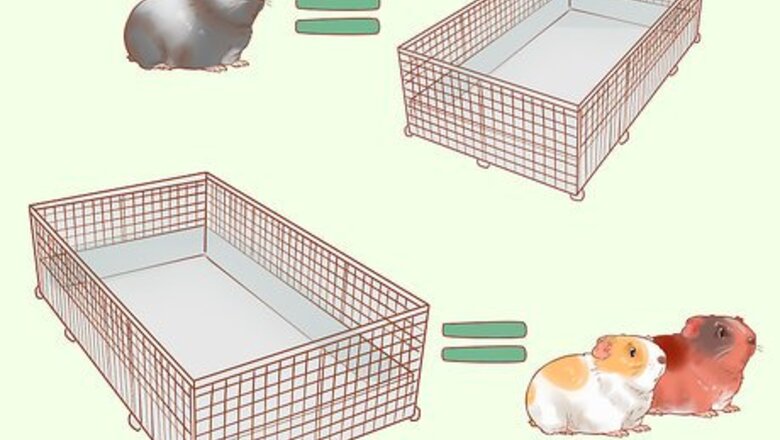
views
Setting Up for Your Guinea Pig
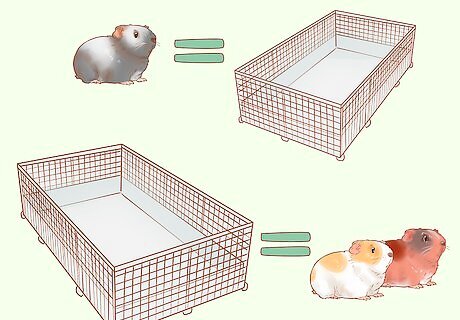
Make a cage. You should allow at least 7.5 square feet of cage space as a minimum for one guinea pig, but for two, normally 8-10 square feet will be fine. However, bigger is always better -- if you have enough space for a larger cage, go for it! Your pigs will appreciate all the space they can get.
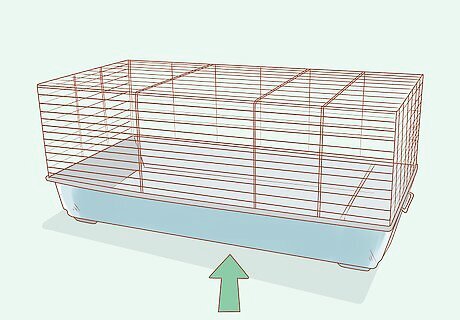
Purchase a cage with a solid bottom. Don't buy anything that has a wire bottom as guinea pigs have very fragile feet that must be protected. Wire flooring will cause bumblefoot.
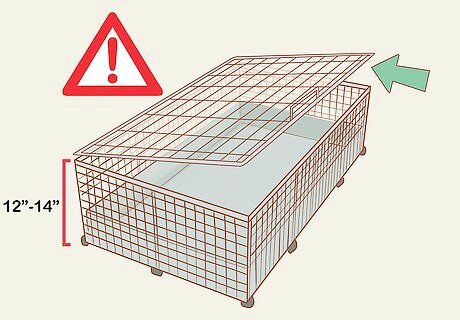
Refrain from a lid if the walls of the cage are at least 12"-14" high. A lid isn't necessary for high built pens. However, it is better to have one in case something is thrown into the cage. The lid might block it. If the cage is to be outdoors or you have little children or dangerous pets in the house then you will need a lid.
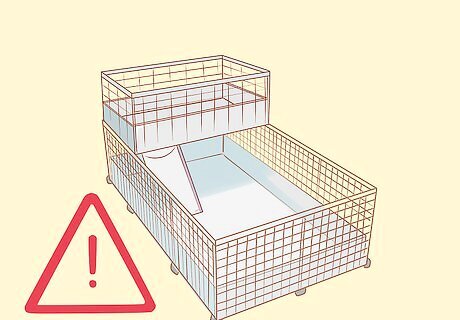
Use caution with multi-level cages. A fall from higher than 6" can injure guinea pig's feet or legs, and elderly guinea pigs should only be kept in flat cages. Keep in mind that your piggy may not be able to climb ramps.

Provide your guinea pig with a few inches of bedding. Line the bottom of their cage with newspaper or puppy pads and add your bedding. Guinea pigs can live on paper bedding, wood shavings, and fleece. Never use cedar chips as it can cause respiratory problems. Aspen or kiln-dried pine are suitable wood options for guinea pigs, but be sure to air them out if they seem especially odorous. If you decide to use paper bedding, take caution as paper holds smell. Be sure to change it at least twice every week or more often if you live in a humid area. You can also use a soft fleece blanket with a UHaul pad or another absorbent layer underneath to absorb everything without having to clean off bedding from your guinea pig. The fleece must be spot cleaned daily.
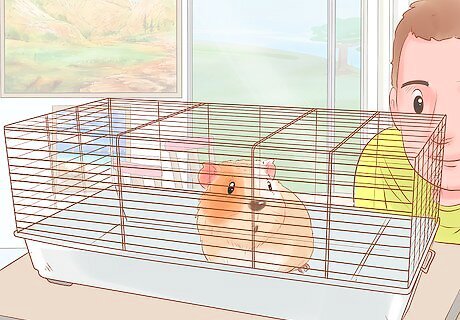
Find a good location for the cage. A place where the family frequents several times a day for extended periods of time is the best location. A living room, bedroom, or hallway is the best choice because there is frequent traffic. Your guinea pigs should get used to their humans. Ensure that no one will trip, push, or knock the cage over. This is fatal to your piggy. Do not place the cage in a garage with cars because the fumes can harm or even kill your guinea pig, and the temperature is usually not regulated in a garage.
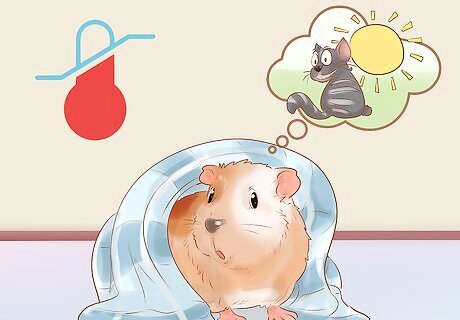
Be aware that guinea pigs are very sensitive to temperature. Many veterinarians recommend keeping them indoors, which has the additional advantage of allowing for more interaction. However, some experts do suggest exposing guinea pigs to sunlight regularly. Avoid outdoors if there are outdoor cats! The best balance of indoor and outdoor time will depend on a variety of factors, including your climate. Talk to your veterinarian to make the best decision for your particular guinea pig.
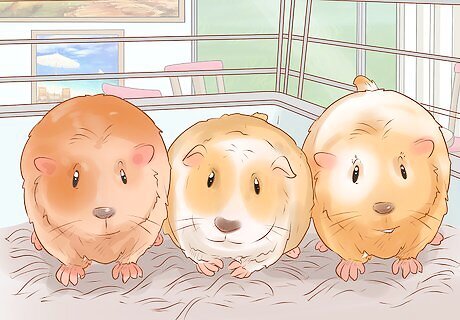
Adopt two or more guinea pigs, so they are not lonely. Guinea pigs need company because they are herd animals. Keeping a sociable animal alone can lead it to become depressed. Keep in mind that you will need to house same-sex pairs, as male and female guinea pigs will mate. You can adopt a male and female providing one or both of the guinea pigs are neutered, otherwise they will breed. If you suspect that the female has become pregnant, separate the Guinea pigs and call your vet for care instructions. Guinea pigs can live in herds of a couple of females and one male that is neutered. A herd imitates groups in the wild. If you hold them in a formation like this, you will most likely notice they are very happy. However, make sure you have enough space! Be sure to properly introduce your guinea pigs to avoid fighting. Have your guinea pigs introduced to each other in a neutral, spacious environment with plenty of hay and food.
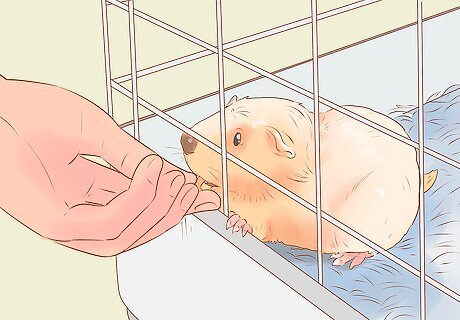
Tame your guinea pig. Sit by the cage and talk to them. This will allow them to get used to your voice and smell. Once they have become accustomed to you being near the cage, try to stick your hand in the cage. If they come up to you, you can try to pet them, but don't chase them around the cage. You can also try by letting them associate you with food. Start by just bringing them their food. Once they get more accustomed to you, try hand feeding.
Feeding Your Guinea Pig
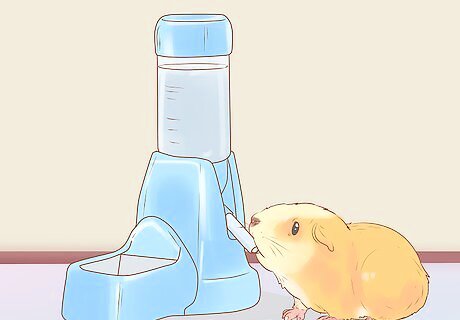
Provide plenty of fresh water. One of the most important elements of caring for any pet is providing it with fresh, clean water at all times. You can use a bowl or a bottle. Bottles are less messy, however, they may leak. Bowls are leak-free and more natural to drink from, but if you use wood shavings, expect to see some mess in the bowl. The best water dispenser is a guinea pig/rabbit bottle with a ball inside the spout to prevent water leaks.
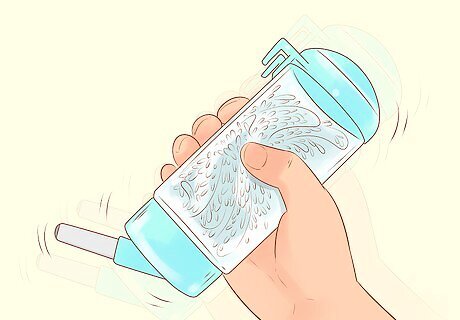
Keep your guinea pigs water bottle/bowl clean and change the water daily. The water bottle itself can be cleaned by placing uncooked rice and a little water in the bottle and then shaking it vigorously. The rice will dislodge any greenish (algae) build-up. Be sure to clean the water bottle nozzle frequently with a Q-tip to keep it free of obstructions and food residue, because they can breed harmful bacteria and clog the water flow. If the cage is in the sun for part of the day, this can contribute to algae build-ups. In this case, cover the bottles with an opaque cloth to avoid most algae.

Make hay available to your guinea pigs constantly. Guinea pigs are grazing animals, so they need something to graze on (such as timothy or orchard grass) at all times, or their digestive tracts can shut down. But, they can also poke their eyes out on it, so make sure to pat-down the hay so no pointed or sharp pieces stick out! Alfalfa hay should only be fed to babies 6 months old and younger, and pregnant or nursing sows because they have a lot of extra calcium that healthy adult guinea pigs do not require. Timothy, orchard grass, or bluegrass hay should be fed for guinea pigs older than 6 months. It should be fed 'free choice,' which means they have some in their cage all the time. Lack of hay can lead to malocclusion, a misalignment of the teeth that may require surgical correction, and GI Stasis, shutting down of the digestive tract, which often leads to death.
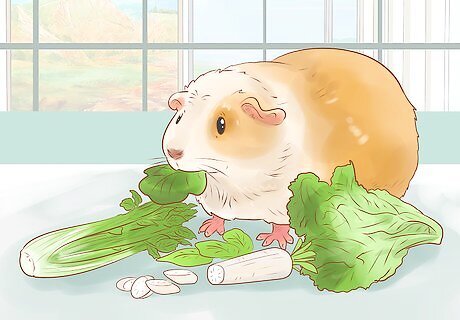
Feed your guinea pigs fresh vegetables daily. Green leafy vegetables should make up about 15% of your guinea pig's diet. Be careful about vegetables that contain a lot of phosphorus, calcium, and Vitamin A, as too many of these can cause stomach upsets and diarrhea, which can be fatal. It is useful to get a list of safe fruits and vegetables from a trustworthy guinea pig website or your local vet. Guinea pig servings should include plenty of vegetables high in vitamin C (as guinea pigs are unable to produce their own vitamin C, and too little of the vitamin can lead to illnesses, such as scurvy). Veggies that are good for guinea pigs include red bell peppers, cabbage, celery, carrots, off-the-vine tomatoes, cucumber, parsley, kale, raw broccoli, small amounts of spinach, and pod-peas. Be sure to limit servings of some vegetables to avoid serious harm to your guinea pig's digestive tract. Some fruits are okay for guinea pigs as treats such as strawberries and apple pieces but these can only be given occasionally as some of the acids can be harmful to guinea pigs. If your guinea pig seems unwilling to eat any vegetables, try cutting them up into slices or small chunks. Also, be aware that guinea pigs may have individual tastes or preferences and may like or dislike different vegetables. Avoid feeding your guinea pigs iceberg lettuce, rocket salads, red leaves, cauliflower, beet greens, potatoes, and radishes. Each guinea pig will require about one cup of vegetables per day. Dividing the veggie meal into two servings is a good idea since guinea pigs are grazing animals who prefer to eat throughout the day instead of eating one big meal.
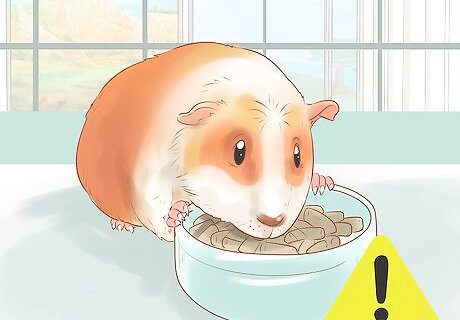
Use pellets sparingly in your guinea pig's diet. Guinea pigs should be fed 1/4 cup of pellets a day. Feed high-quality timothy hay pellets fortified with vitamin C and alfalfa pellets for pregnant or nursing sows and babies 6 months and under. Some recommended brands include Oxbow and Kleenmama. Do not feed a guinea pig rabbit or other small animal pellets - the vitamin content is not the same and can be harmful to your guinea pig. Avoid muesli mixes that encourage selective feeding and ensure that the pellets are seed-free to prevent choking. Plain nuggets are most suitable.
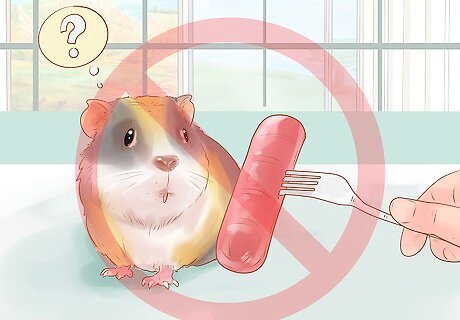
Do not feed your guinea pigs other foods. Pellets, hay, untreated fresh organic grass (wheat or standard lawn grass), and fresh veggies are all the foods that guinea pigs need. Feeding them other types of food can be very harmful to your pig's health.
Exercising and Socializing Your Guinea Pig

Give your guinea pigs some floor time each day. Let them loose in an enclosed space but be sure that no one steps on them. You can do so by setting up a pen in a room (an area with easily-cleaned floors) or outside if it isn't too hot or cold. Make sure to have plenty of space in their exercise area so that they can run and play. This exercise time is crucial to your guinea pig’s happiness. Make sure to put a few toys and tunnels in the play area. Use extra care if allowing your guinea pigs to exercise outside. Guinea pigs should be supervised at all times when outdoors: they can slip through small openings and leave your yard, and predators such as foxes and hawks can get into even the most secure outdoor areas.

Supply your guinea pigs with plenty of toys and cage accessories. You can make your own toys out of boxes, paper bags, oatmeal containers, folders, and more. Be creative and use materials you find around the house.
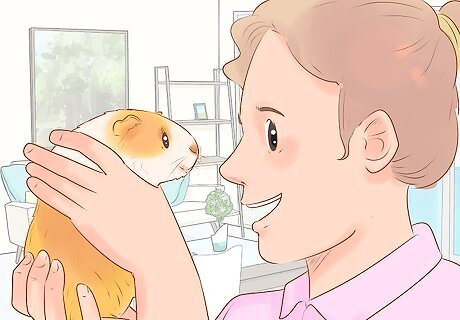
Interact and bond with your guinea pigs several times daily. Guinea pigs are an inherently social species and live in herds or groups in the wild. Frequent handling each day is essential to your guinea pig's happiness. Talk to your guinea pigs, cuddle them, carry them, and pet them as often as you can. Set aside plenty of time to play with your guinea pig. In some countries, it is illegal to buy single guinea pigs: you have to buy them in pairs. Guinea pigs do very well having the companionship of another guinea pig. Guinea pigs can express depression-like symptoms (loss of appetite, inactivity, etc.) if they aren't bonded with appropriately. Guinea Pigs are very smart. You can teach them to stand on their hind legs, spin, jump, and much more!
Keeping Your Guinea Pig Clean and Healthy
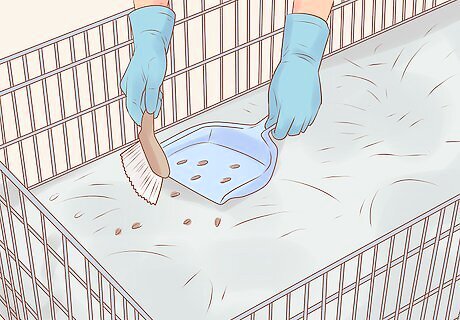
Spot clean your guinea pig's cage. Guinea pigs are relatively clean, so try to clean their cages out at least twice a week, removing droppings and any uneaten veggies from the day before, cleaning the water bottle, and adding more hay to the cage. It is also useful to have two set days in the week where you have the time to do this.
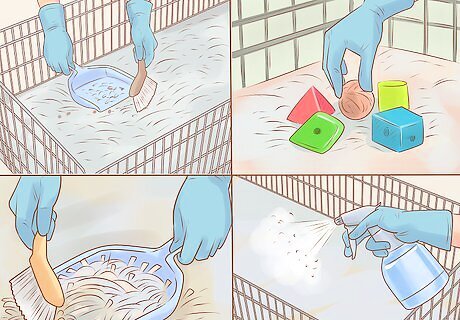
Clean your guinea pig's cage thoroughly at least once a week. The frequency of thorough cleaning depends on the type of bedding used and the number of guinea pigs you have. Remove all debris, liners, bedding, food and toys and dispose of them or clean with a pet friendly antibacterial spray, but be sure to remove any excess cleaners before returning parts to the cage. Don't use cleaning products designed for humans. You may want to wipe down the inside of the cage/hutch with guinea pig friendly antibacterial spray, but you can also just use water and sunshine, which can kill bacteria naturally. You may want to place the cage outside to air out for a short while. Now replace the bedding. It is often useful to put a layer of newspaper under your other bedding to prevent urine stains. The newspaper should not be used for bedding on its own and should not be easily accessed by guinea pigs as they may ingest the ink, which could be harmful. Appropriate bedding for guinea pigs is CareFresh, moisture-wicking fleece over towels, or aspen bedding. Do not use wood chips or sawdust as bedding. Also do not use cedar or pine bedding or pine shavings, as these have harmful phenols. Aspen and kiln-dried pine is fine to use. Towels underneath fleece cut to fit your cage can also be used as cage liners - just shake off the debris, wash and reuse. Be careful that there are no loose threads in the material, as guinea pig's feet can easily become caught in them. Make sure you provide an area for your guinea pig to sleep in - you can buy igloos from most pet stores or you can provide loose hay for them to burrow in. Just remember that they may poke their eyes if you let them burrow in the hay.
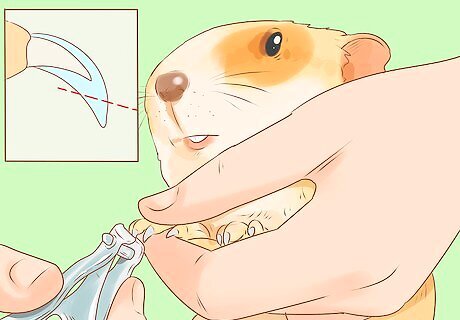
Trim your guinea pig's nails every few weeks. If they have dark nails, shine a flashlight behind the nail so you can see where the quick is. If you clip too close to the blood vessel, the nail may start to bleed. Use styptic powder or cornstarch to stop the bleeding. If you are unsure about clipping the nails, then it is a good idea to go to a veterinarian to have them clipped for the first time. A vet or vet tech can clip them for you and show you what to do in person.
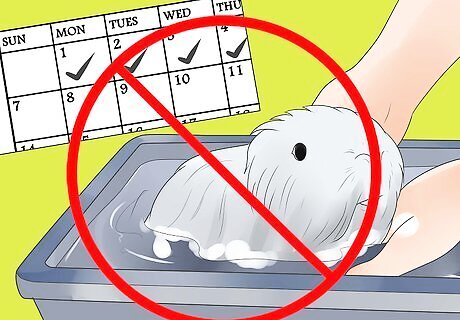
Avoid bathing your guinea pigs frequently. You may wish to give your guinea pigs a bath, but bathing them upsets their natural body processes, so baths should be limited to a few times a year. Long-haired guinea pigs may need 2-3 baths a year.
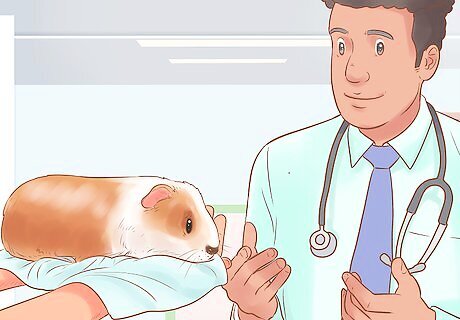
Watch for signs of illness. Know what to look for in an ill pig. Take your guinea pigs to a savvy exotic vet for proper treatment. Always be on the lookout for even the slightest change in habits or appetite as guinea pigs are extremely good at hiding any illness. Make sure all guinea pigs are treated at the same time as some illnesses will spread from one guinea pig to its cage mates.
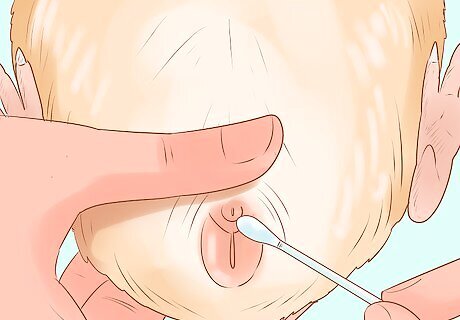
Check your male guinea pig's genital areas. The genital areas on male guinea pigs can become impacted. You can simply massage the area a little and if soft poop-like stuff is present, gently clean out the pocket with a cotton swab. You also need to make sure that no poop clogs the hindquarters as well.
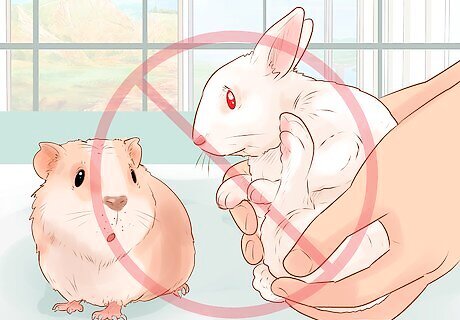
Keep your guinea pigs away from rabbits. Rabbits naturally carry a bacteria that can make guinea pigs very ill, and rabbits are bigger, stronger animals. Even a playful kick from a rabbit could kill a guinea pig.
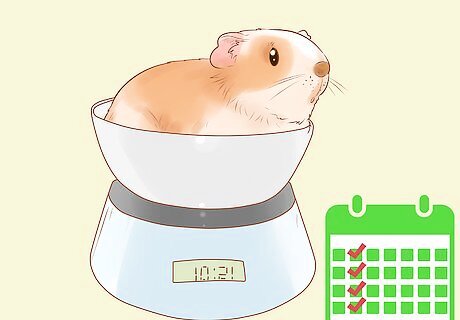
Weigh your guinea pig weekly. A weight fluctuation of up to two ounces is normal but more than that can mean serious dental or other health problems that require the attention of a skilled veterinarian. A digital kitchen scale works best for this.










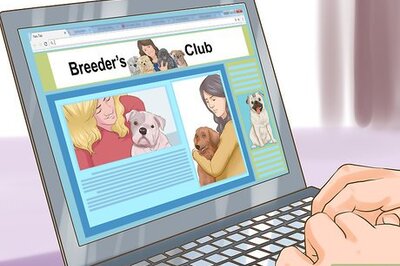

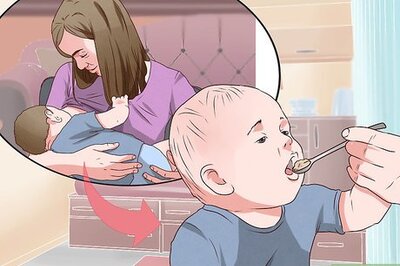
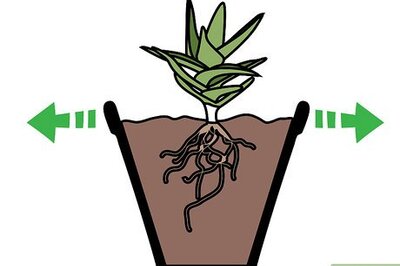




Comments
0 comment